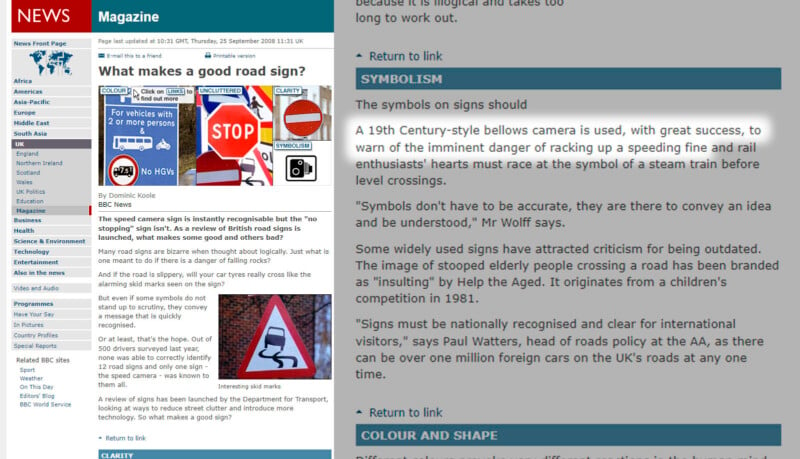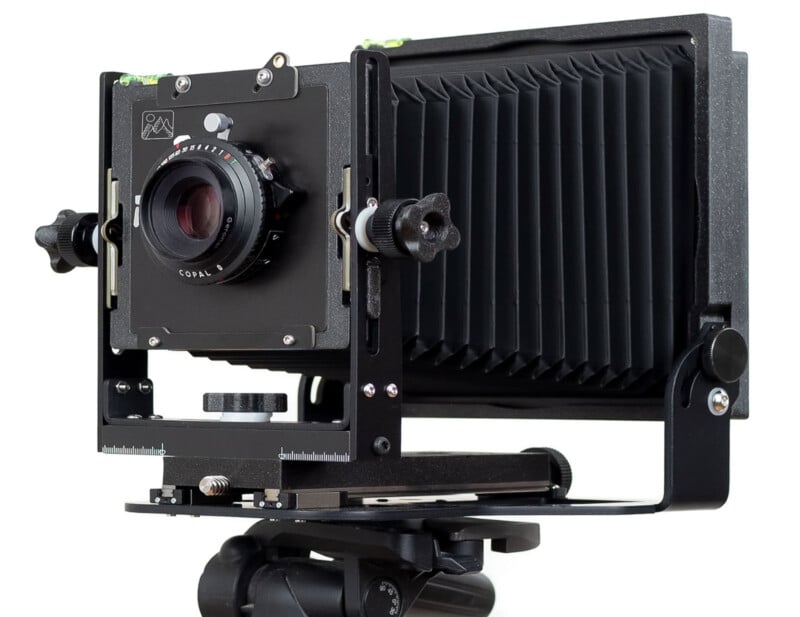Yes, the UK Speed Camera Icon Really Is a 19th-Century Camera
![]()
Last week, a Twitter user took to the social media platform to share something they learned about the speed camera sign, saying that it isn’t a bellows camera, as they had thought “for years,” but rather that the symbol depicts a “boring CCTV camera pointing towards the viewer.”
Roads in the United Kingdom are home to around 7,000 speed cameras, among the most of any country worldwide. These cameras monitor motorists, incentivizing drivers to obey speed limits and punishing those who don’t. The cameras aren’t hidden but instead are frequently accompanied by clear signage. At least the signage is meant to be clear.
But one opinion was published to Twitter last week by a user named Rory, and it spread like wildfire:
for years i thought the UK speed camera sign depicted a Victorian bellows camera pointing to the right, but it’s just a boring CCTV camera pointing towards the viewer :/ pic.twitter.com/sCOVzyRPhW
— rory ・‿・ (@FeyeraBender) April 4, 2023
That’s not true — the sign really is a bellows camera pointed toward the right.
Deception isn’t new to the internet, but what’s noteworthy about the user’s false claim about the UK’s speed camera sign isn’t the misunderstanding itself but how many people agreed with them and the traction the claim got among the press.
“Oh my god,” one user replies. Another adds, “And I was today years old when I realised this…”
Fortunately, among the people who instantly accepted the false claim without question, some resisted the nonsense.
“What are you saying? It’s definitely a bellows camera. Always has been,” writes Dominic Selwood.
“It’s a bellows camera. Same reason we use a steam train [on railroad crossing signs], everyone knows exactly what it represents. Although seemingly that is not the case if you think it’s a CCTV camera drawing,” replies the topical Twitter user Show me a sign, who described himself as “Unapologetically outspoken about Road Signs, Safety, Design, and Active Travel.”
“Show me a sign” hits the mark with the suggestion that everyone knows what the speed camera sign represents. In 2008, BBC referred to the speed camera sign as “instantly recognizable.” In fact, of 500 drivers surveyed in 2007 about a dozen road signs in the UK, only one was known to every respondent — the speed camera sign.
Signage should be instantly recognizable and easy to understand. Drivers must be able to see a sign, even at high speed, and know what they’re looking at. Of the speed camera sign, BBC writes, “A 19th Century-style bellows camera is used, with great success, to warn of the imminent danger of racking up a speeding fine and rail enthusiasts’ hearts must race at the symbol of a steam train before level crossings.”

Despite what was instantly apparent to survey respondents 15 years ago, scores of people were keen to abandon their prior understanding of the UK’s speed camera sign. Perhaps it’s a reflection of the times and the age of Rory’s audience on Twitter. Cameras with bellows are infrequently seen, having been almost entirely supplanted among all but the most avid analog photographers by digital SLR cameras, mirrorless cameras, and smartphones.
Misunderstandings among Twitter users are generally unproblematic. However, what’s disturbing is that press outlets took a simple Twitter post and ran with it.
In its article on the controversy, DebryshireLive wrote, “A Twitter user has shared what the symbol on the speed camera sign stands for.” The article continues, referring to the reality of the sign as “the Victorian camera theory.” It’s not a theory — it’s a fact.
In its coverage, CornwallLive described Rory’s original Twitter post as “fully explaining” the speed camera symbol, and writing that “it seems many motorists have been completely wrong about what they thought the picture actually represents.”
“Have you ever assumed the picture is that of a side-profile camera?” asks CornwallLive. “Well, it turns out it shows something completely different.”
No, it doesn’t.

An article by Mirror refers to people as “distressed” in the face of finding out “what the speed camera symbol shows.”
A Department for Transport spokesperson told The Sun, “We are proud of the sign’s classic design, which takes the Victorian-style bellows camera as its inspiration to produce a clear, understandable symbol.”
The Department for Transport’s traffic signs team designed the signage in-house, likely sometime in the 1990s.
The UK’s first speed camera appeared on the M40 motorway in West London in 1991. In the more than three decades since, motorists have been able to reliably identify speed camera signs, knowing full well that it showed a bellows camera from the side. However, not every speed camera has an accompanying sign. The signs are not a legal requirement but an informational aid to motorists used by local authorities.
That not only dozens of commenters but multiple journalistic institutions so readily abandoned reality because of some random Twitter post is baffling and concerning.
Rory returned to Twitter, advising people to “not let ideologues” lie to them.
don’t let the ideologues lie to you !!!!! https://t.co/cwgiOeXJPo
— rory ・‿・ (@FeyeraBender) April 9, 2023
Rory adds, “shaking my head at this reactionary conspiracy against disenchantment,” leaving open the possibility that his original post was never meant to be taken seriously.
At this point, the truth of Rory’s motivation is beside the point. Whether the intention was to open people’s eyes to the so-called “reality” of the speed camera symbol or stir up a misguided fervor to prove some other point or provide entertainment, the fact remains that news organizations saw a trending Tweet and ran with it.
“Shocking that so many news outlets picked this up with precisely zero evidence,” Andrew S replies to Dominic Selwood.
“I know! Bizarre!” says Selwood.
It may be easy for many to see what someone on Twitter posted and ignore it. “I’m glad I stuck to my guns,” writes Francis Xavier Sowerby Thomas. “This made me angry that whole afternoon.”
However, while some were involved in the heated debate from the start, electing to die on the correct hill, others will have been exposed solely to the articles about the speed camera sign, including the numerous articles that accepted Rory’s original incorrect assertion that the speed camera sign isn’t a bellows camera.
Ultimately, that’s the biggest issue. Someone posted something false for whatever reason, and people allowed their worldview to be immediately altered with zero evidence. Journalistic institutions then covered the situation, parroting lies, thereby spreading misinformation to even more people. Only some of the persuaded readers will ever see the official statement from the Department for Transport, disabusing them of the lie.
People having incorrect notions about what the UK’s speed camera sign displays may not matter much in and of itself. Whether people see it for what it is or not, if people know that it is a speed camera sign — it serves its purpose.
However, the speed camera sign controversy indicates a more significant problem: information spreads rapidly, and people are frightfully quick to accept what they read. Worse yet, some journalists regurgitate nonsense, spreading lies like a pervasive pathogen, infecting readers with falsehoods wrapped up in a pretty package. The “pretty package” is designed to imbue information with an air of authority, even when that authority is thoroughly unearned.
Image credits: UK speed camera logo is in the public domain